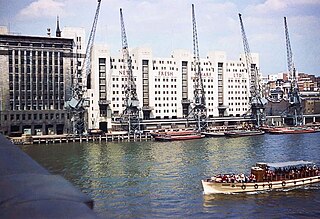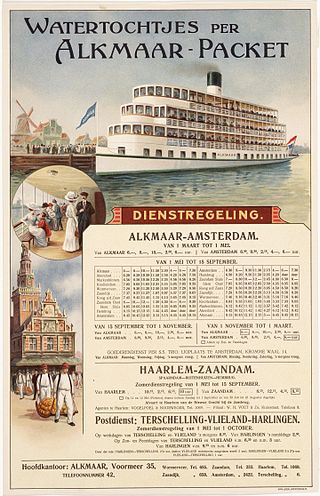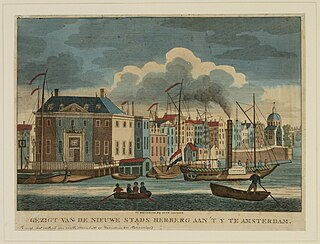This article needs additional citations for verification .(November 2012) |

The Holland Steamship Company (Dutch: Hollandsche Stoomboot Maatschappij, HSM) was formed in Amsterdam in 1885 to run a steamship service from Amsterdam to London.
This article needs additional citations for verification .(November 2012) |

The Holland Steamship Company (Dutch: Hollandsche Stoomboot Maatschappij, HSM) was formed in Amsterdam in 1885 to run a steamship service from Amsterdam to London.
Funnel: Yellow with black top.
| Ship | Launched | Tonnage (GRT) | Notes and references |
|---|---|---|---|
| IJstroom | 1879 | 754 | Purchased from Netherlands Steamship Co. in 1885 as "Fijenoord" and renamed "Ijstroom" starting the familiar naming pattern with the suffix 'stroom' (river) which all the company's vessels carried. Operated to London weekly, becoming twice weekly with the building of the "Amstelstroom". [1] |
| Amstelstroom | 1885 | 787 | Built by Netherlands Steamship Co., at Rotterdam. Sold in 1905 to Greek interests and renamed "Irini", changing hands within Greece again in 1908 renamed "Spezia" and in 1913 renamed "Spetzai". Transferred to Hellenic Steam Navigation and lost during war but was raised and renamed "Spetsai". Became the "Volos" of A.K.Riggas in 1928, and that company was absorbed into Hellenic Coast Lines in 1930. Vessel sank on 7 December 1933 on passage from Piraeus to Savona. [1] |
| Ijstroom | 1898 | 960 | Built by R.Thompson & Son at Sunderland and operated on the London service with "Maasstroom" delivering a twice weekly service. Sold in 1922 to Cie.Nav. France-Irlande and renamed "Banba" and was wrecked off the Newfoundland coast in July 1923 on passage from Sydney, Nova Scotia to Granville. [1] |
| Maasstroom | 1900 | 1,034 | Near sister of "Ijstroom" (1898) built at Rijkee & Co., of Rotterdam and with a slightly increased GRT. Was damaged during an air raid on London during World War I and post war had her passenger capacity reduced to 12. Scrapped by Van Heyghen Freres at Ghent in February 1935. [1] |
| Amstelstroom | 1910 | 1,413 | Built by Maats. Fijenoord of Rotterdam. Served both London and Hull from Amsterdam. Abandoned when damaged by gunfire from German torpedo boats in March 1917 and finally sunk by a torpedo from a German submarine close to the Nord Hinder L/V. [1] |
| Zaanstroom | 1913 | 1,657 | Built by Rotterdam Drydock Co., at Rotterdam. Captured and taken to Zeebrugge by German submarine in March 1915 and eventually scuttled by German Navy in October 1918. Raised by Belgian interests and sold to Soc. Navale Charbonniere and renamed "Westland" in 1919. Sold on to S.S.M in 1922 and again to United Baltic Corporation in 1925 and renamed "Baltanic". Spent World War II mainly in New Zealand waters as a refrigerated feeder ship. Finally being sold to I.C.I. as a storage hulk for explosives in Loch Torridon. Broken up at Troon in May 1958. [1] [3] |
| Lingestroom | 1917 | 1,480 | Near sister of "Zaanstroom". Re-opened London service after World War I, but sold to Thesen's Steamships of Cape Town in 1937 being renamed "Griqua". Operated between Cape Town and the Belgian Congo as a passenger/cargo vessel until 1948 when she was sold to Colonial Steamships of Port Louis, Mauritius and renamed "Chamarel 2". Vessel capsized and sank after an explosion unloading petrol in Saint-Denis, Reunion in September 1949. [1] |
Outside of its passenger / cargo services, HSM operated cargo services to many ports around the coasts of the U.K. and Ireland - see 'Routes' above.
Passengers would occasionally be carried on these vessels but it was on an ad hoc basis.
A feature of the ships deployed on the London service was the mounting of deck cranes to facilitate speedy cargo handling. [1]

Ellerman Lines was a UK cargo and passenger shipping company that operated from the late nineteenth century and into the twentieth century. It was founded in the late 19th century, and continued to expand by acquiring smaller shipping lines until it became one of the largest shipping firms in the World. Setbacks occurred through heavy losses to its merchant fleet in the First and Second World Wars but were overcome in each case.

The Stoomvaart Maatschappij Nederland or SMN, also known as the Netherland Line or Nederland Line, was a Dutch shipping line that operated from 1870 until 1970, when it merged with several other companies to form what would become Royal Nedlloyd.
Gouverneur Generaal Loudon was a mail steamer and excursion vessel which survived the 1883 eruption of Krakatoa.

The Hollandsche IJzeren Spoorweg-Maatschappij [ˈhɔlɑntsə ˈɛizərə(n) ˈspʊːrʋɛxmaːtsxɑˌpɛi] or HSM was the first railway company in the Netherlands founded on 8 August 1837 as a private company, starting operation in 1839 with a line between Amsterdam and Haarlem. The company remained operational until 1938, when it merged with the Maatschappij tot Exploitatie van Staatsspoorwegen (SS) to form the Nederlandse Spoorwegen (NS).
USS Autauga (AK-160) was an Alamosa-class cargo ship commissioned by the US Navy for service in World War II. She was responsible for delivering troops, goods and equipment to locations in the war zone.
Nedlloyd was a Dutch shipping company, formed in 1970 as the result of a merger of several shipping lines:

Zaanland was a steam single-screw cargo ship built in 1900 by Russell and Company of Port Glasgow for Zuid Amerika Lijn of Amsterdam with intention of carrying cattle from Argentina and Uruguay to various ports in Europe, including England. The cargo ship operated on South America to Europe route during her entire career. She was requisitioned by the US Navy in March 1918 and sunk after colliding with another vessel on her first trip under Navy flag two months later.

The Batavier Line was a packet service between Rotterdam and London from 1830 until the 1960s. The line was established by the Nederlandsche Stoomboot Maatschappij.
The first USS Pollux (SP-2573) was a United States Navy cargo ship in commission for three weeks during April 1918.

SS Prinses Amalia was a Dutch steam ship of the Netherland Line

Fresh Wharf was a wharf located in the City of London close to London Bridge, on the north bank of the River Thames. The site was used as a quay in Roman times and later as an unloading place for Anglo-Saxon boats. A wharf was constructed there at some point in the medieval period and appears to have acquired its name from its customary usage as a landing place for fresh fish. In the 16th century, Fresh Wharf was made a "Legal Quay" authorised for the import of certain goods during the reign of Queen Elizabeth I of England. It expanded as London's river-borne trade grew in the 18th and 19th centuries, with large warehouses being established immediately behind the wharf. In the 20th century, the wharf's owners took over the adjoining wharves immediately upstream and downstream, built a new ten-storey warehouse and renamed the site New Fresh Wharf. By the end of the 1960s, however, London's docks had fallen into disuse with the advent of containerization, for which they were not suited, and the wharf was closed down in 1970. An office block was built on the site of the warehouse in 1977 and the former quayside is now part of a public footpath along the Thames.

Alkmaar Packet was a shipping company that operated scheduled passenger and freight services in the northern part of the Netherlands between 1864 and 1950. The services the company provided were a kind of beurtvaart, which at the time had become a forerunner of modern public transport. At its height Alkmaar Packet owned more than 20 ships.
Van der Schuyt, Van den Boom en Stanfries NV, or S.B.S. NV was a Dutch transport company. It was founded in 1948 in a period of change, when shipping companies were becoming trucking companies. It was a merger of three of the biggest inland shipping companies, originally offering scheduled and combined services for passengers, livestock and freight:
SS Ajax was a cargo steamship that was built in Germany in 1923 as Elbe. In 1927 she was renamed twice, first to Ceuta and then to Ajax.

The Koninklijke Nederlandse Stoomboot-Maatschappij (KNSM) was an Amsterdam-based shipping company that existed from 1856 to 1981. It was once the largest company in Amsterdam and one of the top five shipping lines in the Netherlands. The company operated mid-sized freighters that had limited passenger accommodations. At its peak in 1939, the company had 79 vessels. Of these, 48 were lost during World War II.

The Geldersch-Overijsselsche Lokaalspoorweg-Maatschappij (GOLS) was a railway company that owned and serviced several railways in the Dutch provinces of Gelderland and Overijssel. The company was founded by Jan Willink, a textile producer from Winterswijk, who had created the Borken - Winterswijk - Zutphen railway in 1878.

The Nederlandsche Stoomboot Maatschappij ( ), abbreviated as NSM or NSBM, was a Dutch shipping line focused on inland navigation. In the 1820s it was important for the quick introduction of steam power on the Dutch rivers and on the Rhine. NSM owned the major shipbuilding company Fijenoord.

SS De Batavier, launched in 1827 was an early steamship which served on the Rotterdam to London line of the Nederlandsche Stoomboot Maatschappij (NSM). As such she was in news quite often, but the Batavier also appeared in fiction and non-fiction. The Batavier is the location of a chapter of Thackeray's Vanity Fair.

Amsterdamsche Stoomboot Maatschappij was an early Dutch steam shipping company.